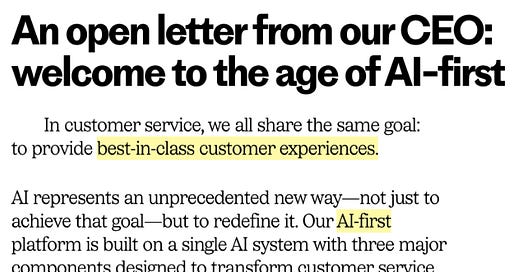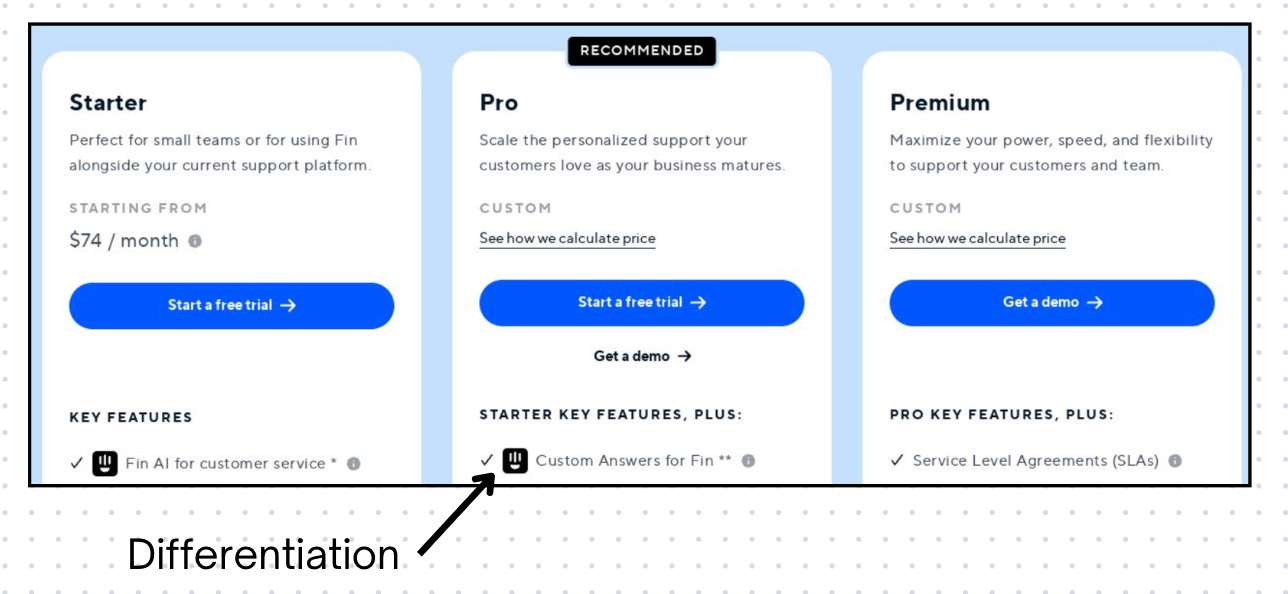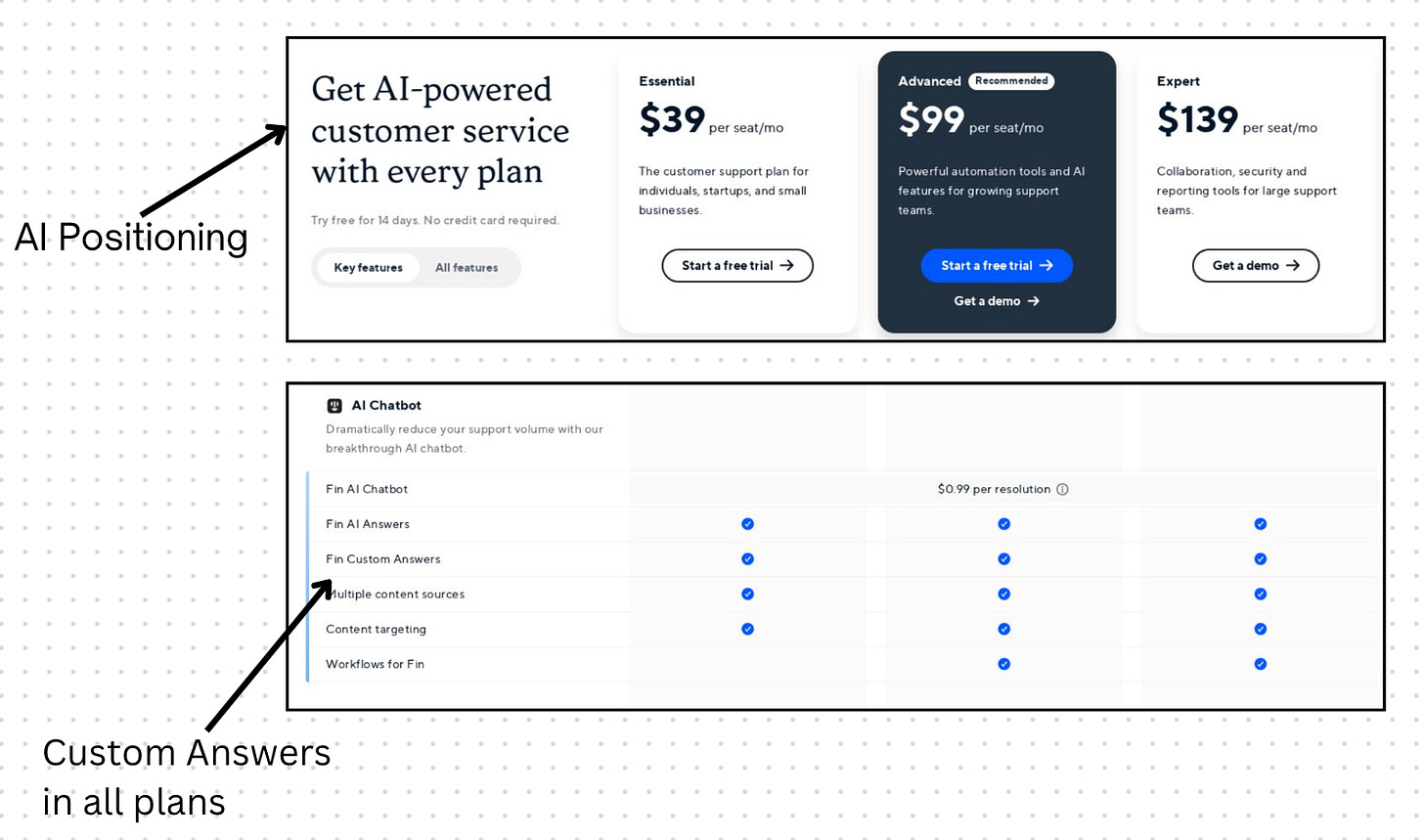Welcome back to Good Better Best!
Quick note — next Tuesday, I’ll be joining a panel to talk pricing for SaaS startups and scaleups. The event is hosted by York IE and J.P. Morgan, and features some good friends from the ProfitWell days. It’s going to be a blast, and highly recommend attending if you’re thinking about pricing heading into 2025. Sign up to join us.
On to this week’s post, where we’re breaking down the evolution of Interco'm’s Fin AI. Let’s get to it.
🚨 SaaS Product and Pricing News
Confluence raised pricing and introduced a new feature.
Freshdesk rebranded its Customer Service product.
Amplitude enriched plan descriptions and introduced new features.
Wrike raised prices and added features.
Apollo cut usage limits on the free plan.
LaunchDarkly raised usage its Free plan.
Harness removed the Startup plan.
Squarespace streamlined plans and plan names.
Intercom’s AI Product Launch Strategy
With Fin AI, Intercom became one of the first SaaS companies to incorporate Generative AI features in their product.
Since then, Intercom has doubled and tripled down. Their current homepage features an actual love letter to AI from the CEO:
Looking back at Intercom’s launch strategy for Fin AI, they did 3 things that any SaaS company can snipe for future product launches.
Let’s break it down.
1. Show Customer’s What’s Coming
Before launching new functionality, Intercom adds the features to the pricing page with a “Coming Soon” label.
They did this when they initially teased Fin AI bot back in June of 2023:
And they’re doing it again now, with upcoming features to Fin AI Agent:
I love three things about the teaser strategy:
It forces the product team to ship the features. If it’s live on the pricing page, it makes it more real and creates urgency.
It gives prospects and customers a window into the Product Roadmap, and builds anticipation.
It also allows Intercom to gauge excitement and demand for upcoming features.
After the teaser, Intercom made the soft launch.
2. Soft launch and iterate based on new information.
When Intercom first launched Fin AI, it wasn’t in its final form. Given how much Generative AI is evolving, this isn’t surprising.
In the initial release, Intercom differentiated the Pro plan with Custom Answers from Fin AI:
However, once they repositioned as an AI-first Customer Service company, they realized Custom Answers needed to be included in every plan:
The lesson here is to not get married to what you’ve already done, and to be willing to change with new information. Over the last year, Intercom has iterated rapidly with Fin AI, and it’s helped them prep for multiple standalone product launches.
3. Make pricing part of the product development process.
You’ve heard it before, but it’s worth repeating — working on pricing before the product launch will save you time, and make the launch more successful. It’s the ultimate “slow down to speed up” situation.
Intercom has now launched two standalone Generative AI products. In both cases, they launched with a thoughtful pricing strategy.
First, they launched AI Chatbot, now known as Fin AI Agent, which has a “per resolution” model and offers an early peak at “outcome-based pricing,” which is an emerging trend:
Then, they launched Fin AI Copilot, which offers a Freemium + Add-On model:
It’s clear by these pricing models that Intercom put thought into it, and likely consulted customers to get feedback. The result is standalone products that are ready to monetize effectively on day one.
Key Takeaways
To recap, there are 3 things Intercom did with Fin AI that any company can steal for their own launches:
Tease features before they’re live. Show customers what’s coming pre-launch. Build excitement. Rally the team. Create urgency to get the features out in the world. Get early feedback on what customers are excited about.
Soft launch and Iterate. Don’t get married to your initial idea. Keep an open mind. Remain open to experimentation as you get new information.
Launch with a Pricing Strategy. Don’t put pricing off for later. Think through it as part of the product development process, and go to market with a pricing model ready to go. It will save you time and endless headaches after the fact.
Thanks for tuning in and see you next week! If you enjoyed this post, share it with a friend.










